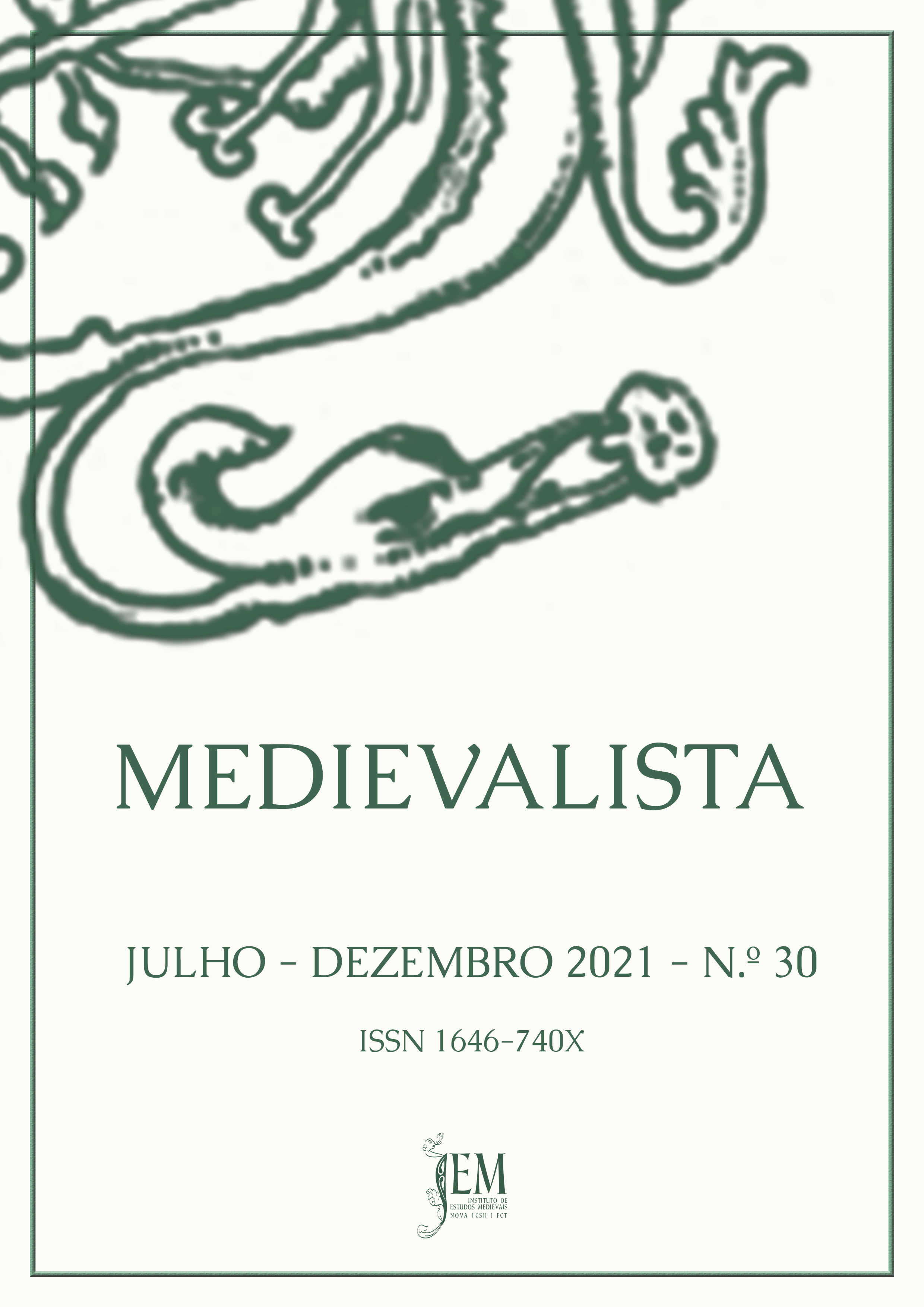A fundação da Ordem de S. João em Jerusalém, ou o Muristan revisitado
DOI:
https://doi.org/10.4000/medievalista.4494Palavras-chave:
Jurusalém, Muristan, Hospitalários, Hospital, Conrad SchickResumo
A ordem de São João foi fundada durante o século XII, a sul da Igreja do Santo Sepulcro em Jerusalém, numa área hoje conhecida como Muristan. O centro do convento da ordem era o outrora famoso hospital, que deu origem a vários albergues e hospitais para peregrinos em toda a Europa. Dado o seu significado histórico, é surpreendente que pouco se saiba sobre este complexo de edifícios. Através dos relatos de peregrinos e dos estatutos da ordem, conhece-se o funcionamento do hospital com alguma segurança. Mas, em consequência de mudanças e de destruições posteriores, só sobreviveram alguns vestígios dessa construção medieval, os quais foram pouco explorados até aos dias de hoje.
O desenvolvimento do Muristan desde a antiguidade até os tempos modernos é o objecto de um projecto de investigação interdisciplinar em curso. No âmbito desse projecto, os registos de arquivo, as plantas e as fotografias foram reavaliados, enquanto os vestígios arquitectónicos preservados e acessíveis estão a ser analisados segundo os métodos da arqueologia da arquitectura. O presente artigo apresenta alguns dos resultados desse projeto sobre o desenvolvimento medieval do Muristan, sede e hospital da Ordem de São João.
Referências bibliográficas
BERKOVICH, Ilya; RE’EM, Amit – “The Location of the Crusader Hospital in the Muristan - a reassessment”. in Vieweger, Dieter; Gibson, Shimon (ed.) – The Archaeology and History of the Church of the Redeemer and the Muristan in Jerusalem; Workshop September 2014. Oxford: Archaeopress Archaeology, 2016, pp. 193-221.
BOAS, Adrian J. – Archaeology of the Military Orders. A survey of the urban centres, rural settlement and castles of the Military Orders in the Latin East (c. 1120-1291), London – New York: Routledge, 2006.
BRUSCHKE, Jonas; CAMIN, Johannes; HEINZELMANN, Michael – “3D-Rekonstruktion des mittelalterlichen Johanniterhospizes in Jerusalem”. Kölner und Bonner Archaeologica. KuBA 2 (2012), pp. 281-287.
BURGTORF, Jochen – The Central Convent of Hospitallers and Templars. History, Organization, and Personnel (1099/1120-1310). Leiden – Boston: Brill, 2008.
HEINZELMANN, Dorothee; et. al. – “Der Muristan in Jerusalem: Vom hadrianischen Forum zum Hospital des Johanniterordens”. Kölner und Bonner Archaeologica. KuBA 4 (2014), pp. 157-177.
HEINZELMANN, Dorothee; et. al. – “The Hospital of St. John in Jerusalem – from the Architectural Remains to a 3D Reconstruction”. in Vieweger, Dieter; Gibson, Shimon (ed.) – The Archaeology and History of the Church of the Redeemer and the Muristan in Jerusalem. Workshop September 2014. Oxford: Archaeopress Archaeology, 2016, pp. 307-321.
HIESTAND, Rudolf – “Die Anfänge der Johanniter”. in FLECKENSTEIN, Josef; HELLMANN, Josef (ed.) – Die geistlichen Ritterorden Europas.
Sigmaringen: Thorbecke, 1980, pp. 31-80.
HUMBERT, Jean-Baptiste – “Excavations at Saint John Prodromos, Jerusalem”. New studies in the archaeology of Jerusalem and its region, collected papers 5 (2011), pp. 24-47.
KEDAR, Benjamin Z. – “A Twelth-century description of the Jerusalem Hospital”. in Nicholson, Helen (ed.) – The Military Orders, Vol. 2: Welfare and Warfare. Aldershot: Routledge, 1998, pp. 3-26.
KLEMENT, Katja – Gottes Gastgeber. Die Ritter des Hospitals von Jerusalem. Die vatikanische Handschrift Vat. Lat. 4852, mit Transkription, Übersetzung und Faksimile. Editio Princeps. Norderstedt: Books on Demand GmbH, 2010.
KRÜGER, Jürgen – “Der Muristan von 1187 bis zum Ersten Weltkrieg”. in Vieweger, Dieter; Gibson, Shimon (ed.) – The Archaeology and History of the Church of the Redeemer and the Muristan in Jerusalem. Workshop September 2014. Oxford: Archaeopress Archaeology, 2016, pp. 255-279.
LUTTRELL, Anthony – “The Hospitallers early Statutes”. Revue Mabillon 14 (2003), pp. 9-22.
LUTTRELL, Anthony – “The Amalfitan Hospices in Jerusalem”. in FARRUGIA, Edward G. (ed.) – Amalfi and Byzantium. Acts of the International Symposium on the Eighth Centenary of the Translation of the Relics of St Andrew the Apostle from Constantinople to Amalfi (1208-2008) (Orientalia christiana analecta, 287). Rome: Pontificio Istituto Orientale, 2010, pp. 105-122.
PIANA, Mathias (ed.) – Burgen und Städte der Kreuzzugszeit. Petersberg: Michael Imhof Verlag, 2008.
PIEROTTI, Ermete P. – Jerusalem explored, being a Description of the Ancient and Modern City. 2 vol. London: Bell and Daldy, 1864.
PRINGLE, Denys – “The Investigation of a Medieval Pit in the Muristan, Jerusalem, by Fr Charles Coüasnon OP, Mr Leonidas J. Collas and Mrs Crysta-M. Bennett in May 1963”. Levant 29 (1997), pp. 201-215.
PRINGLE, Denys – The Churches of the Crusader Kingdom of Jerusalem. A Corpus; vol. III: Jerusalem. Cambridge: Cambridge University Press, 2007.
RE’EM, Amit, el. al. – “Crusader Remains in the Muristan, Old City of Jerusalem. A Decade of Archaeological Gleanings”. Atiqot 66 (2011), pp. 137-154.
RE'EM, Amit; FORESTANI, Renee – “Jerusalem, Old City, The Muristan, Final Report”. Hadashot Arkheologiyot. Excavations and Surveys in Israel [online] 129 (2017) [Accessed 4 June 2020]. Available at http://www.hadashot-esi.org.il/report_detail_eng.aspx?id=25216&mag_id=125.
RILEY-SMITH, Jonathan – The Knights Hospitallers in the Levant, c. 1170-1309. Basingstoke: Palgrave Macmillan, 2012.
SCHICK, Conrad – “The Muristan, or the Site of the Hospital of St. John at Jerusalem”. Palestine Exploration Fund Quarterly Statement 34 (1902), pp. 42-56.
STERN, Eliezer – “La commanderie de l'Ordre des Hospitaliers à Acre”. Bulletin monumental 164 (2006), pp. 53-60.
VIEWEGER, Dieter; GIBSON, Shimon (ed.) – The Archaeology and History of the Church of the Redeemer and the Muristan in Jerusalem. Workshop September 2014. Oxford: Archaeopress Archaeology, 2016.
VINCENT, Louis-Hugues; ABEL, Félix Marie – Jérusalem. Recherches de Topographie, d'Archéologie et d'histoire. 2. Jérusalem nouvelle; 4 fasc. Paris: J. Gabalda, 1914-1926.
WARREN, Charles – Plans, elevations, sections etc. shewing the results of the Excavations at Jerusalem 1867-70 executed for the Committee of the Palestine Exploration Fund. London: Vincent, Brock, Day & Son, 1884.

